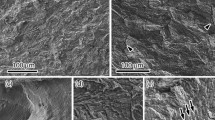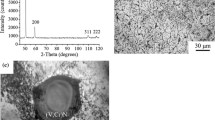Abstract
Gaseous hydrogen embrittlement of quenched and tempered 4130 steel was studied as a function of temperature from −42° to 164°C in a partially dissociated hydrogen environment at low molecular hydrogen pressures (≈8 × 10−3 torr). Atomic hydrogen was created by dissociation of molecular hydrogen on a hot tungsten filament located near a crack opening. The presence of atomic hydrogen was found to increase the rate of hydrogen-induced, slow crack growth by several orders of magnitude and to significantly alter the temperature dependence of embrittlement from what is observed in the presence of molecular hydrogen alone. Based on a previous study, these observations are interpreted in terms of a difference between the hydrogen-transport reaction step controlling hydrogen-induced, slow crack growth in the molecular hydrogen and the atomic-molecular hydrogen environments. Finally, a comparison is made between the kinetics of hydrogen-induced, slow crack growth observed in the presence of atomic-molecular hydrogen and the kinetics of known, possible hydrogen-transport reactions in an effort to identify the reaction step controlling hydrogen embrittlement in the presence of atomic hydrogen.
Similar content being viewed by others
References
D. P. Williams and H. G. Nelson:Met. Trans., 1970, vol. 1, pp. 63–68.
R. J. Walter and W. T. Chandler: ASM Report D8-14.2, ASM Report System, Metlas Park, Ohio, 1968.
H. H. Johnson:Fundamental Aspects of Stress Corrosion Cracking, pp. 439–445, Natl. Assoc. of Corrosion Engineers, Houston, 1969.
A. R. Troiano:Trans. ASM, 1960, vol. 52, pp. 54–80.
A. S. Tetelman:Fundamental Aspects of Stress Corrosion Cracking, pp. 446–464, Natl. Assoc. of Corrosion Engineers, Houston, 1969.
W. F. Brown and J. E. Strawley:Plane Strain Crack Toughness Testing of High Strength Metallic Materials, ASTM Tech. Publ. 410, ASTM, Philadelphia, 1965.
D. Brennan and P. C. Fletcher:Proc. Roy. Soc. London, 1959, vol. A250, pp. 389–408.
S. Dushman:Scientific Foundations of Vacuum Technique, John Wiley & Sons, New York, 1962.
D. O. Hayward and B. M. W. Trapnell:Chemisorption, Butterworths, London, 1964.
G. G. Hancock and H. H. Johnson:Trans. AIME, 1966, vol. 236, pp. 513–16.
H. G. Nelson and J. E. Stein: Ames Research Center, NASA, Moffett Field, Calif., unpublished research.
R. Ash and R. M. Barrer:Phil. Mag., 1959, vol. 48, pp. 1197–1206.
Author information
Authors and Affiliations
Rights and permissions
About this article
Cite this article
Nelson, H.G., Williams, D.P. & Tetelman, A.S. Embrittlement of a ferrous alloy in a partially dissociated hydrogen environment. Metall Trans 2, 953–959 (1971). https://doi.org/10.1007/BF02664224
Received:
Issue Date:
DOI: https://doi.org/10.1007/BF02664224




